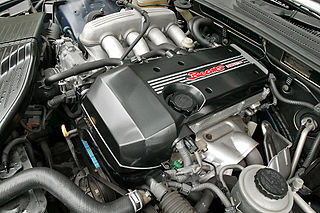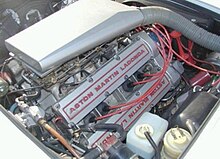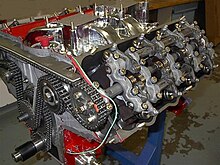
A camshaft is a shaft that contains a row of pointed cams in order to convert rotational motion to reciprocating motion. Camshafts are used in piston engines, mechanically controlled ignition systems and early electric motor speed controllers.

In a piston engine, the cylinder head sits above the cylinders, forming the roof of the combustion chamber. In sidevalve engines the head is a simple plate of metal containing the spark plugs and possibly heat dissaption fins. In more modern overhead valve and overhead camshaft engines, the head is a more complicated metal block that also contains the inlet and exhaust passages, and often coolant passages, Valvetrain components, and fuel injectors.

The Ford Kent is an internal combustion engine from Ford of Europe. Originally developed in 1959 for the Ford Anglia, it is an in-line four-cylinder overhead-valve–type pushrod engine with a cast-iron cylinder head and block.
A combustion chamber is part of an internal combustion engine in which the fuel/air mix is burned. For steam engines, the term has also been used for an extension of the firebox which is used to allow a more complete combustion process.

The Ford CVH engine is a straight-four automobile engine produced by the Ford Motor Company. The engine's name is an acronym for either Compound Valve-angle Hemispherical or Canted Valve Hemispherical, where "Hemispherical" describes the shape of the combustion chamber. The CVH was introduced in 1980 in the third generation European Escort and in 1981 in the first generation North American Escort.

VTEC is a system developed by Honda to improve the volumetric efficiency of a four-stroke internal combustion engine, resulting in higher performance at high RPM, and lower fuel consumption at low RPM. The VTEC system uses two camshaft profiles and hydraulically selects between profiles. It was invented by Honda engineer Ikuo Kajitani. It is distinctly different from standard VVT systems which change only the valve timings and do not change the camshaft profile or valve lift in any way.

The LA engine is a family of overhead-valve small-block 90° V-configured gasoline engines built by Chrysler Corporation between 1964 and 2003. A replacement of the Chrysler A engine, they were factory-installed in passenger vehicles, trucks and vans, commercial vehicles, marine and industrial applications. Their combustion chambers are wedge-shaped, rather than polyspheric, as in the A engine, or hemispheric in the Chrysler Hemi. LA engines have the same 4.46 in (113 mm) bore spacing as the A engines.

The Ford Modular engine is Ford Motor Company's overhead camshaft (OHC) V8 and V10 gasoline-powered small block engine family. Introduced in 1990, the engine family received its “modular” designation by Ford for its new approach to the setup of tooling and casting stations in the Windsor and Romeo engine manufacturing plants.

The Chrysler Hemi-6 engine is a family of inline six-cylinder petrol engines produced by Chrysler Australia in three piston displacements and multiple configurations. Hemi-6 engines were installed in Australian-market Chrysler Valiants from 1970 through 1981. It was also installed in the Valiants closely related variants, the Chrysler VIP, the Chrysler by Chrysler & the Valiant Charger.

An overhead camshaft (OHC) engine is a piston engine in which the camshaft is located in the cylinder head above the combustion chamber. This contrasts with earlier overhead valve engines (OHV), where the camshaft is located below the combustion chamber in the engine block.

An overhead valve (OHV) engine, sometimes called a pushrod engine, is a piston engine whose valves are located in the cylinder head above the combustion chamber. This contrasts with flathead engines, where the valves were located below the combustion chamber in the engine block.

A multi-valve or multivalve engine is one where each cylinder has more than two valves. A multi-valve engine has better breathing, and with more smaller valves may be able to operate at higher revolutions per minute (RPM) than a two-valve engine, delivering more power.

An inlet manifold or intake manifold is the part of an internal combustion engine that supplies the fuel/air mixture to the cylinders. The word manifold comes from the Old English word manigfeald and refers to the multiplying of one (pipe) into many.

The 6G7 series or Cyclone V6 engine is a series of V6 piston engines from Mitsubishi Motors. Five displacement variants were produced from 1986 to 2021, with both SOHC and DOHC, naturally aspirated and turbo charged layouts. While MIVEC variable valve timing has also been implemented in some versions the 2.5, 3.0, and 3.5 L versions were also available with gasoline direct injection. This engine has been the flagship powerplant of the company except when they briefly built a V8 in 1999–2001. The staple of their high-end sedans, it was given twin-turbos for the Mitsubishi GTO, and became the most powerful car ever built by the company at the time.

A flathead engine, also known as a sidevalve engine or valve-in-block engine, is an internal combustion engine with its poppet valves contained within the engine block, instead of in the cylinder head, as in an overhead valve engine.

A tappet, or valve lifter is a valve train component which converts rotational motion into linear motion in activating a valve. It is most commonly found in internal combustion engines, where it converts the rotational motion of the camshaft into linear motion of intake and exhaust valves, either directly or indirectly.

The Chrysler Hemi engine, known by the trademark Hemi or HEMI, refers a series of high-performance American overhead valve V8 engines built by Chrysler with hemispherical combustion chambers. Three generations have been produced: the FirePower series from 1951 to 1958; a famed 426 cu in (7.0 L) race and street engine from 1964-1971; and family of advanced Hemis (displacing between 5.7 L 6.4 L from 2003 to 2024.

The Toyota S Series engines are a family of straight-four petrol engines with displacements between 1.8 and 2.2 litres, produced by Toyota Motor Corporation from January 1980 to August 2007. The S series has cast iron engine blocks and aluminium cylinder heads. This engine was designed around the new LASRE technology for lighter weight – such as sintered hollow camshafts.

A valvetrain or valve train is a mechanical system that controls the operation of the intake and exhaust valves in an internal combustion engine. The intake valves control the flow of air/fuel mixture into the combustion chamber, while the exhaust valves control the flow of spent exhaust gasses out of the combustion chamber once combustion is completed.

The intake/inlet over exhaust, or "IOE" engine, known in the US as F-head, is a four-stroke internal combustion engine whose valvetrain comprises OHV inlet valves within the cylinder head and exhaust side-valves within the engine block.
































